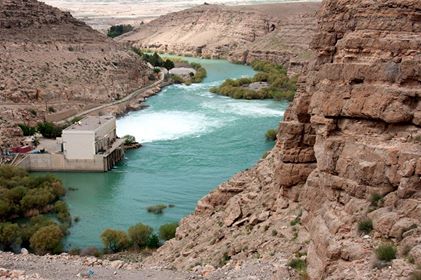Can Afghanistan and Iran work together to reverse an ecological catastrophe, and re-engineer a dead oasis?
The Hamon oasis sits on the Iran-Afghanistan border in the Sistan region, near the Helmand river. The region was previously a roughly 2000-square-kilometer wetland, surrounded by hundreds of kilometres of dry, arid desert – a true oasis.
For thousands of years, surrounding tribes settled around this flourishing oasis to make use of the life-supporting capabilities. It had acted as a major source of food and shelter, but poor management and repeated droughts have proven more challenging than the oasis could withstand.
The wetlands have retreated dramatically. The once flourishing grounds – supporting such species as carp and leopard, and acting as an essential pit stop for migratory birds – have been almost entirely replaced by lifeless salt flats. Towns relying on the diminishing bogs are having to migrate to avoid starvation, as the arising sandstorms curtail any attempt at agriculture.
Though previously settled, significant expansion of the population during the 20th century without optimal irrigation coupled with the worst droughts seen in the region have nearly ended the longstanding oasis.
For years now Afghanistan and Iran had accused the other of being at fault, blaming irrigation practices, water redirection, and other factors.
In 1953, Afghanistan completed construction of the Kajaki dam – one of the two major hydroelectric dams in the Helmand province. It’s considered central to the long-term energy security and economic growth of southern Afghanistan, and as recently as 2016 it has been expanded.
Once the Kajaki dam was built, the Helmand’s flow was reduced, and in 1990 Afghanistan dug irrigation canals to alleviate this. Iranian officials state that the flow of the Helmand river is the most significant influencing factor in the oasis’ disappearance.
However, Afghan officials disagree. They say that virtually nothing has changed on the Afghan side of the border for 40 years (aside from the irrigation canals), and posit that Iranian diversion of water from the Helmand river to supply reservoirs supporting nearby towns in that period is to blame.
After much finger pointing, the two are now discussing solutions.
The united nations development programme (UNDP) has been working with both countries to find a solution that would re-engineer the fading oasis.
The UNDP and the two countries have come up with a two-pronged approach: I) Afghanistan restoring much of the flow of the Helmand river – the main contributor of water to the oasis – and II) for Iran to overhaul its water management practices.
Though this appears simple, in practice it’s dramatically more comple, and may generate a whole host of issues.
The fact that these countries are working on solutions, not placing blame, is an encouraging start.
Time will tell if these efforts are effective, but regardless of the outcome, rationally re-engineering an oasis is undoubtedly a feat for any country and a step forward for science.
Image credit: USACE Afghanistan Engineer District-South via Flickr

